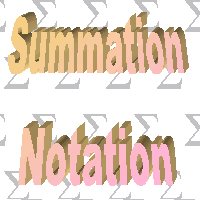4 Jan 1999
 he Notation
he Notation
In mathematics, we often use symbols to simplify mathmatical expression.
Expression like 12 + 22 + 32 + ¼ + n2 is often written in short as år2, which means "the sum of all terms like r2 ".
To be more precise, numbers are placed above and below å to show where the series begins and ends.
Thus
| 12 + 22 + 32 + ¼ + n2 = |
n
å
r = 1
|
r2. |
In general, a finite series am + am + 1 + ¼
+ an, where m £ n, is written as
In this notation,
-
r is called the index of summation (may be replaced by other symbols),
-
ar is the general term of the series,
-
m is the lower limit,
-
n is the upper limit,
-
å is a greek capital letter (read as sigma)
which corresponds to S (for sum).
For infinite series am + am +
1 + ¼, we replace the upper limit
by ¥.
So the representation is
Usually, the lower limit is 1, but it should not be assumed to be always
the case.
n
å
r = 1
|
ar |
= a1 + a2 + ¼ + an . |

 ome Results
ome Results
|
|
|
| |
|
|
| = a |
|
+ b |
|
where a, b are constants |
|
| |
|
|
= nk where k is a constant |
| |
|
|
= ½n(n + 1) |
| |
|
|
= n(n + 1)(2n + 1)/6 |
| |
|
|
= [n(n + 1)/2]2 |
| |
|
|
|

 xamples
xamples
Example 1: Find |
|
n
|
|
|
å
|
(r + 1)(r + 2). |
| r = 1 |
|
|
Solution:
|
|
= |
|
| |
|
= |
|
| |
|
= |
(n/6)(n + 1)(2n + 1) + 3(n/2)(n
+ 1) + 2n |
| |
|
= |
(n/3)[n2 + 6n
+ 11]. |
Example 2: Find |
|
2n
|
|
|
å
|
(2r - 3r2). |
| r = n + 1 |
|
|
Solution:
|
2n
|
|
|
å
|
(2r - 3r2) |
| r = n + 1 |
|
|
= |
| (2n + 1 + 2n + 2 + ¼ + 22n) - 3[ |
|
|
] |
|
| |
|
= |
|
2n + 1(2n - 1)
|
|
| ¾¾¾¾¾¾ |
- 3[(2n/6)(2n
+ 1)(4n + 1) - (n/6)(n + 1)(2n + 1)] |
|
2 - 1
|
|
|
| |
|
= |
22n + 1 - 2n
+ 1 - (n/2)(2n + 1)(7n
+ 1). |






 he Notation
he Notation ome Results
ome Results xamples
xamples